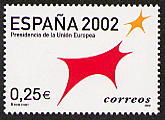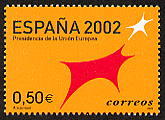| SPAIN.
Thermal ATM issues 2OO5 |
T106
(114) |
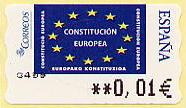 |
|
Date
of issue :
|
|
January
2005 (1st. date:
12.01.05,Madrid/ 13.01.05,Ph.S.) |
|
|
|
47
x 26,5 mm. - Format type 3 |
|
Paper
:
|
|
Thermal
phosphorescent self adhesive |
| Printing
process : |
|
Offset
and invisible ink -
Watermark C |
|
Imprint
:
|
|
Thermal
on black |
|
|
|
0,01
€ to 99,99 € / Set Ph.S.: 0,28-0,53-0,78€ |
|
Design
and printer :
|
|
 RCM-FNMT. Real Casa de la Moneda - Fabrica
Nacional de Moneda y Timbre
RCM-FNMT. Real Casa de la Moneda - Fabrica
Nacional de Moneda y Timbre |
|
|
|
91004
/ 100.000.000 of adhesive labels (approx.) |
|
| Click
on the image to enlarge |
|

|
The
new ATM issue was released jointly with a stamp
of the same subject, on January 12th 2005 by the president
of Correos, Jose Damian Santiago, and the Spanish
Secretary of State for European Affairs, Alberto Navarro.
The media in Spain covered the event widely. |
In total they produced 1 million traditional stamps and 100
million ATM labels. These were the approximate quantities used in
Spanish post offices for frankings up to the date of the referendum
for the European Constitution, on February 20th.
The rolls of this design have been distributed to all the post offices
in Spain within two weeks following the date of issue, with the instruction
to use them immediately, in franking balances, until exhaustion.
This distribution system was also used with the ATM issue 11-M.
The manufacture of the 100 million labels of this issue
was made in 2 phases, both in December 2004. It's unusual, but
this time it's possible to recognize the adhesive labels made in one phase
or the other, because the manufacturing company, RCM-FNMT, used
different security cutting dies.
In
the images it's possible to see how the papers made initially (Type
I) have a much more smooth wavy side than the papers
manufactured in the second phase of production (Type II).
Other objective differences between the phases of manufacture are
not appraised or can't be applied to all the rolls.
The difference in the side waves is enough to distinguish
the two types of papers. |
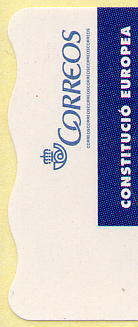 |
 |
 |
 |
| 1st
manufacture - Type I |
2nd
manufacture - Type II |
RCM-FNMT made the first production run of less than 50 million
labels, and these were the first rolls (Type I) distributed and
used in the post offices. They later completed the production, on reaching
100 million units. Most post offices received the rolls of this design
in 2 separate deliveries.
| On
the control labels of the rolls
of this design we can also find indications about the double
production. The last 5 digits located at the end, in
the reference number, indicate the number of the roll (44074
in this case). The first rolls, with the labels with smoother
undulations (Type I), have a lower numeration, whereas
the rolls manufactured later -as this one of the image- has a higher
numeration from 25-30000, and contains the labels with the more
prominent undulations (Type II). |
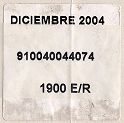 |
With approximate productions of 50 million labels per design, the
total number of rolls does not exceed 26 or 27000 pieces
(26000 rolls x 1900 labels per roll = 49400000 labels). Therefore, all
the rolls have numbers between 00001 and 26 to 27000. But we see as for
this design that these quantities are largely exceeded.
On
March 25th 1957, 6 countries (Germany, Belgium, France,
Holland, Italy and Luxembourg) decided in Rome
on the Treaty for the European Economic Community (EEC).
Over the following years this was complemented by other treaties,
like Maastricht, Amsterdam, etc...
In 2001, in Laeken, Belgium, the 15 Heads of the
member States of the European Union at that time, decided to
convene a European Convention to prepare a document modifying
the existing European treaties.
This European Convention, composed of 105 members representing
the governments of the member States, began its work on February
28th, 2002, and presented the project of the new Constitution
for Europe between June and July of 2003.
|

|
This
Constitutional Treaty was signed in Rome on
October 29th, 2004 by the Heads of State or Governments
and the Ministers of Foreign Affairs of the 25 member
States of the European Union. |
|
After
signing, each member state must ratify the Constitution
according to its own laws. The Spanish Government
have called a referendum on February 20th, 2005.
Under the slogan "Los primeros con Europa"
(The first with Europe), the Spanish Government have
started an informative campaign on the referendum
for the European Constitution.
|
 |
|
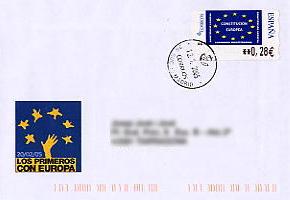
|
The
consolidation and future of a united Europe, a Europe
of 25 member States and 450 million citizens, happens
through the establishment of a common Constitution.
The European Constitution replaces most of the current
Treaties.
Cover with 1st day postmark, 12.1.2005
(J. L. Martin) |
|
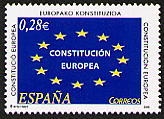 |
On
the same day, January 12th, 2005, a stamp dedicated
to the European Constitution was issued. The face value is
0.28 EUR (inland mail) with a printing of 1.000.000 units.
The design is very similar to the ATM issue and reproduces
the flag and symbol of the European Union, twelve golden
stars on a blue background, and the text 'European Constitution'
in the 4 official languages of Spain. |
|
Official
First Day Cover of the stamp and commemorative postmark.
|
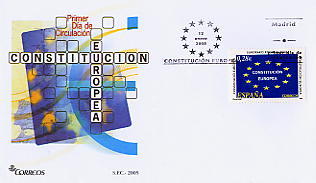 |
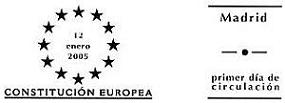 |
With this stamp, the Spanish Philatelic Service will have issued
10 sets (25 stamps) on the European Union from
the 1986 issue, dedicated to the admission of Spain into
the EEC. Other subjects have been the elections to the European
Parliament, the Spanish presidencies of the European Union,
the countries of the Euro zone or the latest, the expansion
of the European Union.
 |
The
first set of this subject was issued on January 7th, 1986
and is composed by 4 stamps, issued like a booklet. The issue
commemorates the admission of Spain and Portugal in the European
Economic Community (image reduced).
On May 9th, 1989 the first stamp was issued commemorating
the Spanish Presidency of the European Communities.
On June 12th, 1989, a stamp commemorated the celebration
of the Elections to the European Parliament.
The
issue of November 4th, 1992 announced the Single European
market. |
 |
 |
 |
 |
On
October 21st, 1994, a stamp dedicated to the Western
European Union.
In
July 1st, 1995 Spanish philately commemorates
again the Spanish Presidency of the European Union.
The
sheet Paises Euro (Euro countries) was
issued in May 28th, 1999 and it include 12 stamps with
the European flag and the member countries of the Euro zone
(right image) |
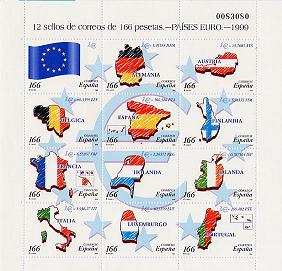 |
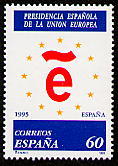 |
2002 was again the turn of Spain to preside over the
European Union, and again Spanish philately commemorated
it with the issue of two stamps with the logo.
Finally, on May 3rd., 2004, the stamp dedicated to the fifth
Expansion of the European Union was issued.
The European Union and the idea of Europe is a great
subject with a possible thematic philatelic collection.
ATM
Web - Spain and Latin American Postal Services: http://www.ateeme.net
© J. Jove - M. Sans. ATEEME.
Variable value stamps study group.
All rights reserved
This page was created: 14.01.05 and last updated:
21.07.05
. English
edition rewritted by S. Goodman (21.07.05)
|




















